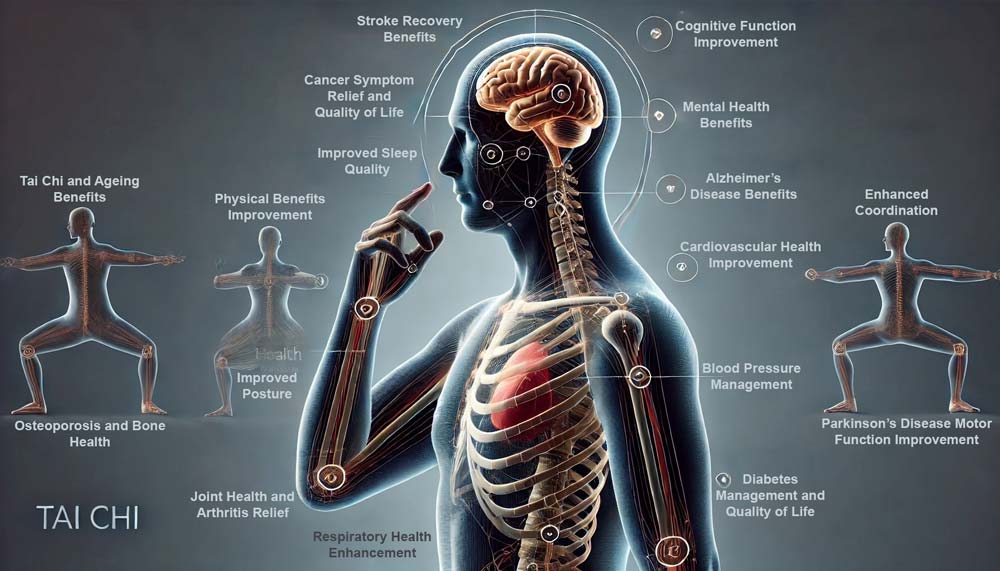The benefits of Tai Chi caught my attention as I researched holistic health practices for BeSund. This ancient Chinese art form emerged as a recurring theme across various wellness topics, revealing itself as a powerful tool for enhancing physical and mental health.
Tai Chi’s gentle, flowing movements mask a robust system nurturing body and mind. Its impact supports physical fitness and offers many health benefits that have piqued the interest of practitioners and researchers alike.
I became increasingly drawn to Tai Chi’s versatility as I developed exercise, fitness, and wellness content. Its adaptability makes it accessible to individuals of all ages and fitness levels, presenting a unique approach to wellness that aligns seamlessly with contemporary health objectives.
The rich history and philosophy underlying Tai Chi provide insights into the balance of mind, body, and spirit—concepts that hold increasing value in our fast-paced, stress-filled world. When applied to modern life, this ancient wisdom offers a path to improved well-being that many find appealing.
Scientific research on Tai Chi adds another layer of credibility to its traditional claims. Studies are beginning to provide evidence for what practitioners have long known – that Tai Chi can significantly enhance physical health, mental well-being, and overall quality of life.
The benefits of Tai Chi span an impressive range, from improving balance and flexibility to reducing stress and anxiety. This practice offers a gentle yet effective approach for those managing chronic conditions or seeking to boost their overall wellness.
The world of Tai Chi is vast and filled with valuable insights. Its history, underlying principles, and practical applications hold relevance for anyone interested in holistic health. Tai Chi presents opportunities for growth and improved well-being. This post will outline the art’s origins and examine its health benefits.
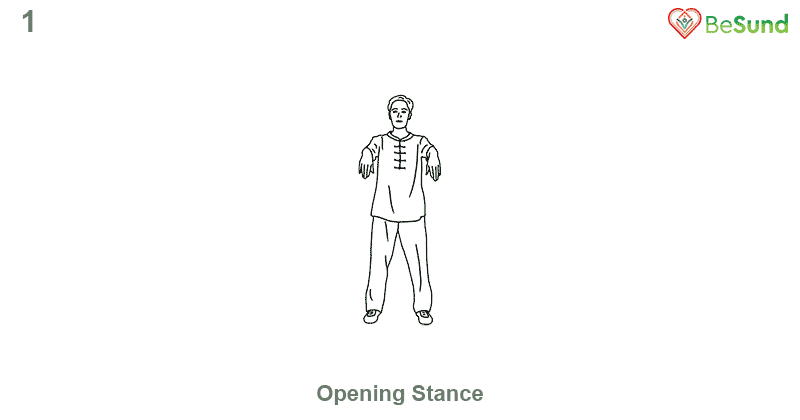
History and Philosophy of Tai Chi
Tai Chi, an ancient Chinese practice, combines martial arts, meditation, and health benefits. Its roots stretch back thousands of years, evolving from Taoist philosophy and the concept of Yin and Yang.
This internal martial art emphasises the cultivation of ‘chi’ or life energy, harmonising mind and body through slow, graceful movements. The benefits of Tai Chi have been recognised for centuries, contributing to its enduring popularity.
The practice of Tai Chi offers a unique blend of physical exercise and mental discipline. It stands apart from many Western exercise programs by focusing on internal energy flow rather than external muscular force. This holistic approach has contributed to Tai Chi’s enduring popularity and reputation as a powerful tool for health and wellness.
Ancient Origins of Tai Chi Philosophy
Tai Chi’s philosophical foundations lie in ancient Chinese thought, particularly the concept of ‘Tao’ or ‘the way’. This idea emphasises living in harmony with nature’s forces. The principles include:
- Balance of Yin and Yang
- Cultivation of ‘chi’ or life energy
- Harmony between mind and body
These concepts shaped Tai Chi’s development, influencing its movements and health applications. The practice aims to align one’s energy with the universe’s natural rhythms, promoting overall well-being. Early practitioners recognised the benefits of Tai Chi for both physical and mental health.
The Evolution of Tai Chi as a Martial Art
Tai Chi’s journey from a philosophical concept to a martial art occurred gradually. Its development as a fighting system is often attributed to the legendary Taoist monk Zhang Sanfeng, circa 12th century CE. Notable aspects of its martial evolution include:
- Integration of soft, circular movements
- Emphasis on internal energy over brute force
- Application of Yin-Yang principles in combat
This unique approach to martial arts set Tai Chi apart. It focuses on redirecting an opponent’s energy rather than meeting force with force. The benefits of Tai Chi in combat situations led to its widespread adoption among martial artists.
Benefits of Tai Chi for Mind and Body
Tai Chi’s holistic approach yields numerous health advantages.
Physical benefits include:
- Improved balance and flexibility
- Enhanced strength and cardiovascular health
- Better posture and body awareness
Mental health benefits of Tai Chi:
- Stress reduction
- Increased focus and concentration
- Enhanced emotional wellbeing
Moreover, Tai Chi’s meditative aspects promote mindfulness, helping practitioners achieve a sense of inner calm and balance.
Principle Figures in Tai Chi’s Development
Several individuals played crucial roles in shaping Tai Chi:
- Zhang Sanfeng: Legendary founder of Tai
- Chi Chen Wangting: Credited with developing the Chen style
- Yang Luchan: Founder of the Yang style, popularised Tai Chi
These masters contributed to Tai Chi’s growth, refining its techniques and spreading its practice beyond small, secluded communities. Their teachings emphasised the numerous benefits of Tai Chi for health and self-defence.
The Five Family Styles and Their Benefits of Tai Chi
Tai Chi evolved into five main styles, each offering unique benefits:
Chen Style:
- Oldest form
- Characterised by explosive movements
- Benefits: Builds strength and stamina
Yang Style:
- Most popular worldwide
- Gentler, flowing movements
- Benefits: Improves balance and relaxation
Wu Style:
- Compact movements with an inclined stance
- Benefits: Enhances coordination and body alignment
Wu/Hao Style:
- Emphasises internal chi cultivation
- Benefits: Deepens meditation and energy awareness
Sun Style:
- Incorporates elements from other internal martial arts
- Benefits: Improves agility and internal energy circulation
Each style offers its distinct benefits of Tai Chi, catering to different physical abilities and personal preferences.
Health Benefits of Tai Chi
The benefits of Tai Chi encompass a wide range of physical and mental health improvements. Combining gentle exercises with mindfulness, this ancient Chinese practice has garnered significant attention from researchers worldwide. Studies have consistently shown that Tai Chi can positively impact various aspects of health, from stress reduction to improved balance and cognitive function.
Tai Chi’s holistic approach to wellness makes it an attractive option for individuals of all ages and fitness levels. Its low-impact nature and focus on controlled movements make it particularly beneficial for those with chronic conditions or limited mobility.
In this section, I will explore the benefits of Tai Chi across various wellness topics, including mental health, physical benefits, ageing, and specific conditions such as Alzheimer’s disease, arthritis, cardiovascular health, and more. I will also discuss how Tai Chi can benefit other medical conditions not covered in our main wellness topics, providing a comprehensive overview of its wide-ranging health impacts.
Mental health benefits
The benefits of Tai Chi for mental health are well-documented, with numerous studies highlighting its positive effects on stress reduction, anxiety management, and mindfulness. Research has shown that regular Tai Chi practice can significantly improve overall psychological well-being and quality of life.
One critical advantage of Tai Chi is its ability to reduce symptoms of depression and anxiety. A systematic review found that Tai Chi consistently demonstrated positive effects on mental health, particularly for women with coronary artery disease and elderly individuals. The meditative aspects of Tai Chi, which emphasise focused breathing and present-moment awareness, contribute to its stress-reducing properties.
Physical benefits
The physical benefits of Tai Chi are extensive, encompassing improvements in balance, flexibility, and muscle strength. Research has consistently demonstrated that regular Tai Chi practice can enhance these crucial aspects of physical fitness, particularly in older adults and those with chronic conditions.
Numerous systematic reviews have found that Tai Chi improves balance outcomes, especially in sedentary or fall-risk populations. These improvements in balance are often attributed to Tai Chi’s emphasis on weight shifting and controlled movements, which enhance proprioception and body awareness.
Regarding muscle strength, studies have shown positive effects of Tai Chi on lower-limb strength, particularly in previously inactive adults. The slow, controlled movements and semi-squat postures common in Tai Chi contribute to this strength-building effect.
While evidence for flexibility improvements is less extensive, preliminary studies suggest that Tai Chi may enhance flexibility, especially in previously sedentary individuals.
Tai Chi and Ageing
The benefits of Tai Chi for ageing populations are particularly noteworthy, with research indicating its potential to slow down physical and cognitive decline. Studies have consistently shown that Tai Chi can improve various aspects of health in older adults, contributing to healthier ageing.
In cognitive function, systematic reviews have found that Tai Chi is associated with improved attention and processing speed. These cognitive benefits are consistently compared to active control groups, suggesting that Tai Chi offers unique advantages for maintaining mental acuity later in life.
Physically, Tai Chi has demonstrated excellent evidence for preventing falls in older adults living in the community. Multiple systematic reviews have found that Tai Chi practice is associated with a decreased risk of falls, typically linked to static and dynamic balance improvements. Some research has even identified Tai Chi as the most cost-effective intervention for fall prevention.
Furthermore, long-term Tai Chi practice has been associated with improved memory and structural and functional alterations of the hippocampus in elderly individuals.
Benefits for Alzheimer’s Disease
While research explicitly focusing on Alzheimer’s Disease is limited, the benefits of Tai Chi for cognitive function and dementia offer promising insights. Studies have shown that Tai Chi can improve mental performance in older adults, including those with cognitive impairment and dementia.
Systematic reviews have demonstrated that Tai Chi improves executive function in people with dementia more effectively than physical activity alone. This suggests that the mind-body integration inherent in Tai Chi practice may offer unique cognitive benefits for individuals with or at risk of Alzheimer’s Disease.
Moreover, research has shown that Tai Chi can improve cognitive function in older adults with mild cognitive impairment, which is often a precursor to Alzheimer’s Disease. These improvements in cognitive function could potentially support memory and mental abilities in individuals with or at risk of Alzheimer’s Disease.
The meditation and relaxation aspects of Tai Chi may help reduce anxiety and depression, potentially improving cortisol levels and other stress-related pathways associated with cognitive decline.
Arthritis and Joint Health
Numerous studies have documented the benefits of Tai Chi for arthritis and joint health. Research indicates that Tai Chi practice can significantly reduce joint pain and improve mobility in individuals with various forms of arthritis.
Multiple systematic reviews have consistently found that Tai Chi improves pain, stiffness, and physical function in individuals with osteoarthritis, particularly knee osteoarthritis. The American College of Rheumatology has included Tai Chi as a conditional recommendation for managing hand, hip, and knee osteoarthritis, further supporting its potential benefits for joint health.
Studies have also shown promising results for individuals with rheumatoid arthritis. A randomised controlled trial found that participants who completed 12 weeks of Tai Chi showed more significant improvements in pain, physical function, and depression compared to an attention control group.
Cardiovascular Health
Tai Chi has shown promising evidence of benefit for cardiovascular health, particularly in the context of cardiac rehabilitation. Several systematic reviews have consistently found positive effects of Tai Chi on cardiovascular health, especially for individuals with coronary artery disease.
Multiple studies have demonstrated that Tai Chi can lower systolic and diastolic blood pressure. A recent larger trial published in the American Journal of Cardiology found that Tai Chi reduced blood pressure and body mass index in elderly participants, providing more robust evidence for its potential in managing hypertension.
The benefits of Tai Chi for cardiovascular health go beyond blood pressure management. Research has shown improvements in various indicators of cardiovascular health among Tai Chi practitioners, including reduced heart rate, increased heart rate variability, and improved lipid profiles.
Tai Chi and Cancer
In recent years, research has increased on the benefits of Tai Chi for cancer patients. Studies have shown that Tai Chi can play a valuable role in managing cancer-related symptoms and improving the overall quality of life for cancer patients and survivors.
Systematic reviews and meta-analyses have demonstrated that Tai Chi can benefit cancer patients’ cancer-specific quality of life and fatigue. These findings suggest that Tai Chi may be a valuable complementary therapy for managing symptoms and improving overall well-being.
In a study involving advanced lung cancer patients, Tai Chi showed promising results in terms of feasibility and adherence. The Tai Chi group participants demonstrated higher adherence to supervised sessions and self-practice than those in the aerobic exercise group.
Diabetes
While the benefits of Tai Chi for diabetes management are still being studied, some promising results have emerged. Research has focused on Tai Chi’s potential to help with blood sugar control and insulin sensitivity in individuals with type 2 diabetes.
A study found that Tai Chi Chuan practice improved fasting glucose levels compared to fitness walking in older adults with type 2 diabetes and mild cognitive impairment. This suggests that Tai Chi may offer unique benefits for blood sugar management in diabetic patients.
However, it’s important to note that systematic reviews on Tai Chi and diabetes have not shown a direct benefit in blood sugar control as measured by haemoglobin A1c levels (HbA1c measures average blood sugar over 2-3 months). Despite this, a study found that Tai Chi did improve the quality of life for individuals with diabetes, suggesting potential indirect benefits. These findings indicate that while Tai Chi may not directly impact blood sugar levels, it could still play a valuable role in overall diabetes management.
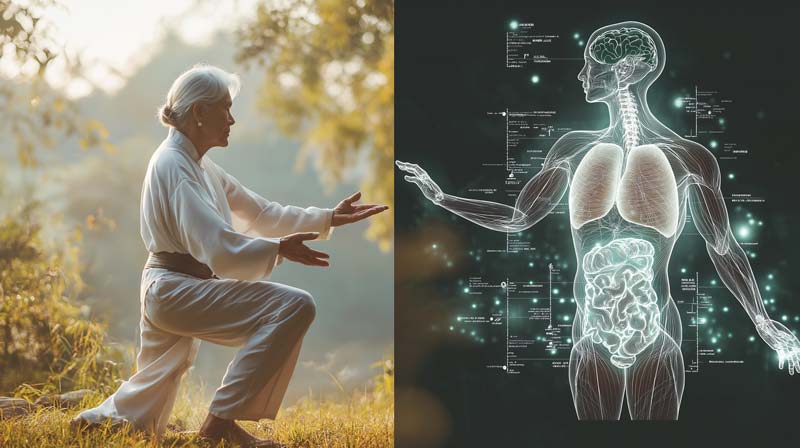
High Blood Pressure
The benefits of Tai Chi for managing high blood pressure have been consistently demonstrated in various studies. Research has shown that regular Tai Chi practice can contribute to lowering both systolic and diastolic blood pressure.
Several systematic reviews have found that Tai Chi can effectively lower blood pressure. A recent larger trial published in the American Journal of Cardiology provided more robust evidence for Tai Chi’s potential in managing hypertension, showing that it reduced blood pressure in elderly participants.
Interestingly, some studies have shown that Tai Chi can be as effective as conventional exercise in reducing blood pressure. This suggests that Tai Chi could be a viable alternative or complementary approach to managing hypertension, especially for individuals who may have difficulty with more strenuous forms of exercise. The relaxation and mindfulness components of Tai Chi likely contribute to its blood pressure-lowering effects, offering a holistic approach to hypertension management.
Osteoporosis and Bone Health
Tai Chi practice has shown promising results for individuals concerned with osteoporosis and bone health. Research indicates potential benefits in increasing bone density and preventing falls, which are crucial for maintaining skeletal integrity.
Systematic reviews have reported mixed results regarding Tai Chi’s impact on bone mineral density (BMD). Some studies have shown reduced BMD decline rates in postmenopausal women who practice Tai Chi compared to sedentary controls. A trial study found that combining Tai Chi with resistance training yielded the best outcome for bone health.
Fall prevention is another critical aspect of bone health, and Tai Chi has demonstrated excellent evidence. Multiple systematic reviews have consistently found that Tai Chi practice is associated with a decreased risk of falls in older adults living in the community. These improvements are typically linked to enhancements in static and dynamic balance, which are chief components of Tai Chi practice.
Parkinson’s Disease
For individuals with Parkinson’s Disease, Tai Chi offers potential improvements in balance, motor skills, and possibly tremor reduction. Long-term Tai Chi training has significantly benefited Parkinson’s patients in several fundamental areas.
A 3.5-year follow-up study showed that regular Tai Chi practice led to slower motor function deterioration compared to a control group. The annual increase in the Unified Parkinson’s Disease Rating Scale (UPDRS) total score was significantly lower across multiple follow-ups in the Tai Chi group.
Balance and gait improvements have been consistently observed in Parkinson’s patients engaging in Tai Chi. Studies have shown continuous improvement in the Berg Balance Scale (BBS) and Timed Up and Go (TUG) tests throughout Tai Chi interventions. These enhancements in balance and motor function can significantly impact the quality of life for individuals with Parkinson’s Disease.
Respiratory Health
Tai Chi practice has shown excellent evidence for improving respiratory health, particularly in individuals with chronic obstructive pulmonary disease (COPD). Research has focused on Tai Chi’s potential to enhance lung capacity and improve breathing techniques.
Systematic reviews have consistently found that Tai Chi practice is associated with improvements in several respiratory parameters. These include enhanced results in the 6-minute walk test, reduced dyspnea, and improved forced expiratory volume in 1 second (FEV1).
A study that revealed improvements in overall exercise capacity and health-related quality of life for COPD patients who regularly practice Tai Chi showed the benefits of Tai Chi for respiratory health. The combination of gentle movements and focused breathing in Tai Chi likely contributes to these respiratory health improvements.
Sleep
Regular Tai Chi practice has been associated with improved sleep quality and potential reductions in insomnia symptoms. Research has explored how this mind-body exercise can positively impact sleep patterns and overall rest.
Systematic reviews have found that Tai Chi can improve sleep quality in older adults. These reviews suggest that Tai Chi practice is associated with better self-reported sleep outcomes and may benefit individuals experiencing insomnia.
Recent studies have also investigated the potential mechanisms behind Tai Chi’s effects on sleep. Research has shown that Tai Chi practice can reverse cellular and genomic markers of inflammation associated with poor sleep in older adults with insomnia. This suggests a potential physiological basis for the sleep improvements observed in Tai Chi practitioners.
Stroke Recovery
Tai Chi has shown promising evidence of benefit for stroke rehabilitation, offering potential improvements in balance, motor function, and muscle control. Several studies have explored how this gentle exercise can aid post-stroke recovery.
Systematic reviews have found positive effects of Tai Chi on various aspects of stroke recovery, including balance, gait, and quality of life in stroke survivors. These improvements can significantly impact the rehabilitation process and long-term outcomes for stroke patients.
Clinical trials have provided further support for these benefits. One study found that Tai Chi improved physical function, reduced fall rates, and enhanced quality of life among older stroke survivors. Another study focusing specifically on balance and gait in chronic stroke patients found that therapeutic Tai Chi improved these areas.
Additional Health Benefits of Tai Chi
Tai Chi’s benefits and versatility extend to several other health conditions, showcasing its potential as a complementary therapy across various medical fields. Here’s an overview of some additional areas where Tai Chi has shown promise:
Musculoskeletal Health
Tai Chi may offer relief for individuals with low back pain. A systematic review and recent trials suggest beneficial pain management and functional improvement effects.
Fibromyalgia
Several systematic reviews indicate that people with fibromyalgia (a condition causing widespread pain and fatigue) who practice Tai Chi report less pain and improved function.
Neurological Conditions
Preliminary trials have shown promising results for Tai Chi in improving balance and quality of life in individuals with multiple sclerosis.
Mental Health
Disorders Recent studies suggest Tai Chi may benefit individuals with schizophrenia, particularly in improving physical therapy outcomes and psychophysiological effects.
Cognitive Function
Some studies have found that Tai Chi may improve attention and cognitive function in healthy adults, suggesting potential neuroprotective effects.
HIV and Substance Abuse
A study involving adults with HIV and substance abuse issues found that those who received cognitive behavioural therapy followed by Tai Chi reported reduced pain intensity and decreased substance use.
Posttraumatic Stress Disorder (PTSD)
In a study of patients with PTSD, 90% of individuals believed their health would improve with Tai Chi. After completing a Tai Chi program, participants reported reduced pain intensity.
These diverse findings highlight Tai Chi’s potential as a holistic approach to health, offering benefits across a broad spectrum of medical conditions. As research continues, we may uncover more ways Tai Chi can contribute to overall health and well-being.
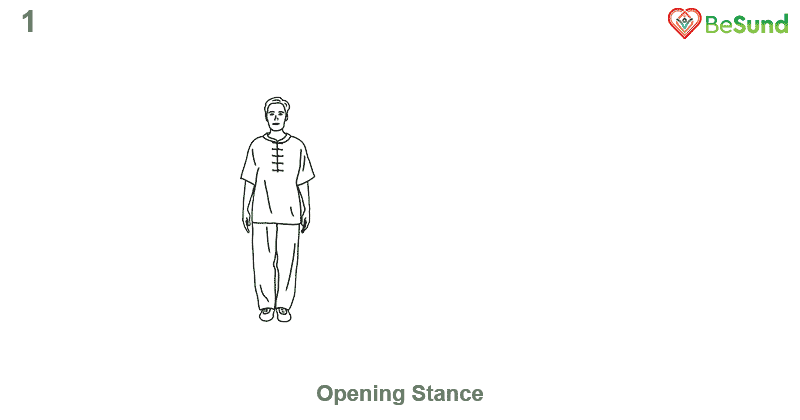
How to Start Practicing Tai Chi
Tai Chi practice begins with proper preparation. To begin, find a quiet space where you can move freely. Wear comfortable, loose-fitting clothes and flat-soled shoes. Start with these foundational steps:
- Learn proper breathing: Focus on deep, slow breaths from your diaphragm.
- Master the basic stance: Stand with feet shoulder-width apart and knees slightly bent.
- Practice mindfulness: Cultivate awareness of your body and surroundings.
Once you’re comfortable with these basics, you can begin learning the Tai Chi form. A typical sequence unfolds through consistent practice of the following sequence:
- Begin Tai Chi
- Grasp the Sparrow’s Tail: Right, then Left
- Wardoff, Rollback, Press, Push Forward
- Single Whip
- Lift Hands to the Up Posture
- The Crane Spreads Its Wings
- Brush Knee and Step Forward: Left
- Play the Guitar
- Twist Body, Brush Knee and Step Forward: Left, Right, Left
- Play the Guitar
- Twist Body, Brush Knee and Step Forward: Left
- Twist Body and Circle the Fist
- Step Forward, Deflect Downward, Parry and Punch
- Seal Tightly
- Embrace the Tiger and Return to the Mountain
The form continues with more complex movements:
- Punch under the Elbow
- Step Back and Repulse the Monkey: Left, Right, Left
- Diagonal Flying
- Pick Up the Needle from the Sea Bottom
- Fan Back
- Wave Hands in the Clouds: Right, Left, Right
- Stand High to Search Out the Horse
- Separate Right Foot, then Left Foot
- Turn and Kick with the Heel: 90 degrees
As you progress, you’ll learn additional movements like “The Fair Lady Weaves with Shuttle” and “The Snake Creeps Down”. The benefits of Tai Chi increase as you master these forms and integrate them into a fluid sequence.
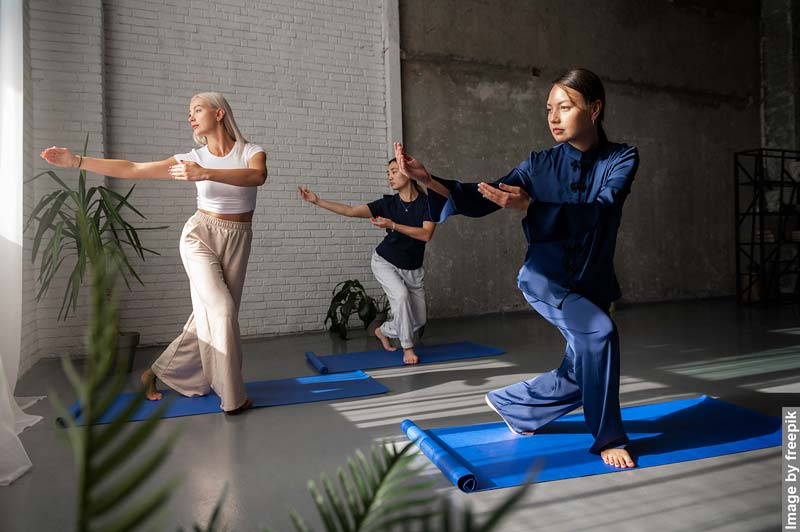
The Lasting Benefits of Tai Chi for Health and Wellness
The benefits of Tai Chi include lasting positive impacts on physical and mental well-being. This ancient practice has proven valuable across various age groups and health conditions. It is a versatile addition to many wellness routines.
Long-term Tai Chi practitioners often experience sustained balance, flexibility, and strength improvements. Physical enhancements contribute significantly to fall prevention, particularly for older adults. Moreover, regular practice has been associated with better cardiovascular health, including lower blood pressure and improved heart rate variability.
Tai Chi’s impact on mental health is equally noteworthy. Consistent practice has been linked to reduced symptoms of anxiety and depression, enhanced cognitive function, and improved sleep quality. Also, the mental health benefits persist over time, potentially contributing to a better overall quality of life as individuals age.
The holistic nature of Tai Chi makes it particularly valuable for individuals managing chronic conditions. Studies have shown its potential in alleviating symptoms associated with arthritis, fibromyalgia, and Parkinson’s disease. Cancer patients and survivors have also reported improved fatigue levels and well-being through regular Tai Chi practice.
Tai Chi’s gentle, low-impact nature makes it accessible to people of various fitness levels and ages. Individuals, from young adults to seniors, can adapt the practice to suit their needs and capabilities. This adaptability ensures that the benefits of Tai Chi can be enjoyed throughout different life stages.
Combining physical movement, breath control, and mindfulness in Tai Chi creates a synergy that supports physical and mental health. The mind-body connection fosters a holistic approach to wellness, potentially leading to more comprehensive health improvements over time.
As research continues to uncover the long-term effects of Tai Chi, its role in promoting lifelong health and wellness becomes increasingly evident. The breadth of its benefits, from physical strength to mental clarity, positions Tai Chi as a valuable practice for everyone seeking a balanced approach to health.
Sources
- Burschka JM, Keune PM, Oy UH, Oschmann P, Kuhn P. Mindfulness-based interventions in multiple sclerosis: beneficial effects of tai chi on balance, coordination, fatigue and depression. BMC Neurol. 2014;14(1):165.
- Chen Y, Qin J, Tao L, Liu Z, Huang J, Liu W, Xu Y, Tang Q, Liu Y, Chen Z, Chen S, Liang S, Chen C, Xie J, Liu J, Chen L, Tao J. Effects of Tai Chi Chuan on Cognitive Function in Adults 60 Years or Older With Type 2 Diabetes and Mild Cognitive Impairment in China: A Randomised Clinical Trial. JAMA Netw Open. 2023 Apr 3;6(4):e237004.
- Cheung DST, Takemura N, Lam TC, Ho JCM, Deng W, Smith R, Yan Y, Lee AWM, Lin CC. Feasibility of Aerobic Exercise and Tai-Chi Interventions in Advanced Lung Cancer Patients: A Randomized Controlled Trial. Integr Cancer Ther. 2021 Jan-Dec;20:15347354211033352.
- Ding M. Tai chi for stroke rehabilitation: a focused review. Am J Phys Med Rehabil. 2012;91(12):1091–6.
- Du S, Dong J, Zhang H, Jin S, Xu G, Liu Z, et al. Taichi exercise for self-rated sleep quality in older people: a systematic review and meta-analysis. Int J Nurs Stud. 2015;52(1):368–79.
- Gillespie LD, Robertson MC, Gillespie WJ, Sherrington C, Gates S, Clemson LM, et al. Interventions for preventing falls in older people living in the community. Cochrane Database Syst Rev. 2012;(9):CD007146.
- Guo JB, Chen BL, Lu YM, Zhang WY, Zhu ZJ, Yang YJ, et al. Tai chi for improving cardiopulmonary function and quality of life in patients with chronic obstructive pulmonary disease: a systematic review and meta-analysis. Clin Rehabil. 2016;30(8):750–64.
- Hochberg MC, Altman RD, April KT, Benkhalti M, Guyatt G, McGowan J, et al. American College of Rheumatology 2012 recommendations for the use of nonpharmacologic and pharmacologic therapies in osteoarthritis of the hand, hip, and knee. Arthritis Care Res. 2012;64(4):465–74.
- Irwin MR, Olmstead R, Breen EC, Witarama T, Carrillo C, Sadeghi N, et al. Cognitive behavioral therapy and tai chi reverse cellular and genomic markers of inflammation in late life insomnia: a randomised controlled trial. Biol Psychiatry. 2015;78(10):721–9.
- Kim H, Kim YL, Lee SM. Effects of therapeutic tai chi on balance, gait, and quality of life in chronic stroke patients. Int J Rehabil Res. 2015;38(2):156–61.
- Lauche R, Langhorst J, Dobos G, Cramer H. A systematic review and meta-analysis of tai chi for osteoarthritis of the knee. Complement Ther Med. 2013;21(4):396–406.
- Lauche R, Cramer H, Häuser W, Dobos G, Langhorst J. A systematic overview of reviews for complementary and alternative therapies in the treatment of the fibromyalgia syndrome. Evid Based Complement Alternat Med. 2015;2015:610615.
- Lee MS, Jun JH, Lim HJ, Lim HS. A systematic review and meta-analysis of tai chi for treating type 2 diabetes. Maturitas. 2015;80(1):14–23.
- Liao, W. (1990). Tai Chi Classics. Shambhala Publications.
- Li F, Harmer P, Fitzgerald K, et al. Tai Chi and postural stability in patients with Parkinson’s disease. N Engl J Med 2012;366:511–9.
- Li G, Huang P, Cui S-S, et al. Mechanisms of motor symptom improvement by long-term Tai Chi training in Parkinson’s disease patients. Transl Neurodegener 2022;11:6.
- Liu B, Liu ZH, Zhu HE, Mo JC, Cheng DH. Effects of tai chi on lower-limb myodynamia in the elderly people: a meta-analysis. J Tradit Chin Med. 2011;31(2):141–6.
- Liu X, Miller YD, Burton NW, Chang JH, Brown WJ. The effect of tai chi on health-related quality of life in people with elevated blood glucose or diabetes: a randomised controlled trial. Qual Life Res. 2013;22(7):1783–6.
- Manson J, Rotondi M, Jamnik V, Ardern C, Tamim H. Effect of tai chi on musculoskeletal health-related fitness and self-reported physical health changes in low income, multiple ethnicity mid to older adults. BMC Geriatr. 2013;13:114.
- Moore AA, Lake JE, Glasner S, Karlamangla A, Kuerbis A, Preciado D, Jenkins J, Dominguez BX, Candelario J, Liao DH, Tang L, Reid MC. Establishing the feasibility, acceptability and preliminary efficacy of a multi-component behavioral intervention to reduce pain and substance use and improve physical performance in older persons living with HIV. J Subst Abuse Treat. 2019;100:29–38.
- Nery RM, Zanini M, Ferrari JN, Silva CA, Farias LF, Comel JC, et al. Tai chi chuan for cardiac rehabilitation in patients with coronary arterial disease. Arq Bras Cardiol. 2014;102(6):588–92.
- Song R, Ahn S, So H, Lee EH, Chung Y, Park M. Effects of t’ai chi on balance: a population-based meta-analysis. J Altern Complement Med. 2015;21(3):141–51. Epub 2015 Feb 4.
- Sungkarat S, Boripuntakul S, Chattipakorn N, Watcharasaksilp K, Lord SR. Effects of tai chi on cognition and fall risk in older adults with mild cognitive impairment: a randomised controlled trial. J Am Geriatr Soc. 2017;65(4):721-727.
- Sun J, Buys N. Community-based mind-body meditative tai chi program and its effects on improvement of blood pressure, weight, renal function, serum lipoprotein, and quality of life in Chinese adults with hypertension. Am J Cardiol. 2015;116(7):1076–81.
- Taylor-Piliae RE, Hoke TM, Hepworth JT, Latt LD, Najafi B, Coull BM. Effect of tai chi on physical function, fall rates and quality of life among older stroke survivors. Arch Phys Med Rehabil. 2014;95(5):816–24.
- Thomas GN, Hong AWL, Tomlinson B, et al. Effects of tai chi and resistance training on cardiovascular risk factors in elderly Chinese subjects: A 12-month longitudinal, randomised, controlled intervention study. Clinical Endocrinology. 2005;63:663–9.
- Tsai P-F, Kitch S, Chang JY, James GA, Dubbert P, Roca JV, Powers CH. Tai chi for posttraumatic stress disorder and chronic musculoskeletal pain: a pilot study. J Holist Nurs. 2018;36(2):147–158.
- Vera-Garcia E, Mayoral-Cleries F, Vancampfort D, Stubbs B, Cuesta-Vargas AI. A systematic review of the benefits of physical therapy within a multidisciplinary care approach for people with schizophrenia: an update. Psychiatry Res. 2015;229(3):828–39.
- Wang C, Schmid CH, Iversen MD, Harvey WF, Fielding RA, Driban JB, Price LL, Wong JB, Reid KF, Rones R, McAlindon T. Comparative Effectiveness of Tai Chi Versus Physical Therapy for Knee Osteoarthritis: A Randomised Trial. Ann Intern Med. 2016 Jul 19;165(2):77-86.
- Wang C, Bannuru R, Ramel J, Kupelnick B, Scott T, Schmid CH. Tai chi on psychological well-being: systematic review and meta-analysis. BMC Complement Altern Med. 2010;10:23.
- Wang C, Collet JP, Lau J. The effect of Tai Chi on health outcomes in patients with chronic conditions: a systematic review. Arch Intern Med 2004;164:493-501.
- Wang F, Lee EO, Wu T, Benson H, Fricchione G, Wang W, et al. The effects of tai chi on depression, anxiety, and psychological well-being: a systematic review and meta-analysis. Int J Behav Med. 2014;21(4):605–17.
- Wang H, Yu B, Chen W, Lu Y, Yu D. Simplified tai chi resistance training versus traditional tai chi in slowing bone loss in postmenopausal women. Evid Based Complement Alternat Med. 2015;2015:379451.
- Wayne PM, Walsh JN, Taylor-Piliae RE, Wells RE, Papp KV, Donovan NJ, et al. Effect of tai chi on cognitive performance in older adults: systematic review and meta-analysis. J Am Geriatr Soc. 2014;62(1):25–39.
- Wayne PM, Kiel DP, Krebs DE, Davis RB, Savetsky-German J, Connelly M, et al. The effects of tai chi on bone mineral density in postmenopausal women: a systematic review. Arch Phys Med Rehabil. 2007;88(5):673–80.
- Wu W, Liu X, Wang L, Wang Z, Hu J, Yan J. Effects of tai chi on exercise capacity and health-related quality of life in patients with chronic obstructive pulmonary disease: a systematic review and meta-analysis. Int J Chron Obstruct Pulmon Dis. 2014;9:1253–63.
- Yang, J. M. (1990). The Essence of Tai Chi Chi Kung: Health and Martial Arts. YMAA Publication Center.
- Young DR, Appel LJ, Jee S, Miller ER., 3rd The effects of aerobic exercise and tai chi on blood pressure in older people: Results of a randomised trial. Journal of the American Geriatrics Society. 1999;47:277–84.
- Yuan QL, Guo TM, Liu L, Sun F, Zhang YG. Traditional Chinese medicine for neck pain and low back pain: a systematic review and meta-analysis. PLoS One. 2015;10(2):e0117146.
- Yue C, Yu Q, Zhang Y, et al.. Regular tai chi practice is associated with improved memory as well as structural and functional alterations of the hippocampus in the elderly. Front Aging Neurosci. 2020;12:586770.
- Zheng G, Liu F, Li S, Huang M, Tao J, Chen L. Tai chi and the protection of cognitive ability: a systematic review of prospective studies in healthy adults. Am J Prev Med. 2015;49(1):89–97.
- Zeng Y, Luo T, Xie H, Huang M, Cheng AS. Health benefits of qigong or tai chi for cancer patients: a systematic review and meta-analyses. Complement Ther Med. 2014;22:173-186.


